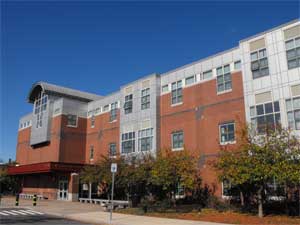Superintendent to make recommendation May 24 By George P. Hassett In one Somerville school building parents are debating if their children are getting two different educations. The Arthur D. Healey School in Winter Hill has operated separate learning programs for Somerville kids since the 1980s when the Choice program was added to the neighborhood school. The Choice program bills itself as focusing on project-based learning and parents go through a lottery system to get their children enrolled. |
||||
Four current School Committee members have sent their children to the Choice side of the school. "It looked like a more active learning program," said Ward 4 School Committee member Christine Rafal, who represents the neighborhood on the committee.
The neighborhood school program serves many of the children from the nearby Mystic Avenue housing project. Ninety percent of the children in the neighborhood program receive free or reduced lunch compared to 38 percent in the Choice program. The neighborhood program is composed of 90 percent minority students, while the Choice program is 43 percent minority.
"In short, the status quo hurts students, divides and distracts adults and is unacceptable," said Healey Principal Mike Sabin in a presentation to parents and city and school officials this month.
He said faculty and parents compete over resources and have had trouble moving forward together while neighborhood program kids suffer emotionally and academically when they're isolated from their peers.
Now, parents are asking if their children are receiving different educations at the two programs, and if quality education in Somerville falls along class or racial lines.
Ward 5 School Committee member Mark Niedergang sent his daughter to the Choice program and said her experience prepared her for the higher grades but he said the perception that students are separated by race and class at the school "is very troubling to many people."
Superintendent Anthony Pierantozzi said he will make a recommendation at a May 24 meeting at the Healey School on how to resolve the split. He is expected to choose one of three options Sabin proposed. Those three options are:
• A multiple school option in which both programs are more balanced, such as equalizing the number of classrooms in the two programs, but the existing two school structure remains.
• A one school option in which the two programs are merged into a unified Healey school that maintains elements of the existing programs such as parent involvement, project based learning and university partnerships.
• A two school option in which Choice moves to a different building.
At a May 7 community forum organized by OneVille, a new community organization funded by the Ford Foundation, parents expressed concern that the School Coimmittee would handle the final decision.
"The School Committee doesn't represent the reality of the community," said one woman. "So it has to be balanced because there is no minority representation in the school committee. And you know, it's going to be the process of the parents and the minorities are not going to be heard or thought about it."
Mica Pollock, a Choice parent and OneVille organizer, said Healey parents are still looking for basic information about the differences between the two programs.
Pierantozzi said his decision will be based on educational concerns and financial issues will not impact his recommendation.
"There is no intention to keep students of different races or socioeconomic backgrounds apart," Pierantozzi said. "Quite the opposite, we have a strong history of celebrating the diversity of our students, parents and staff in Somerville."













Reader Comments